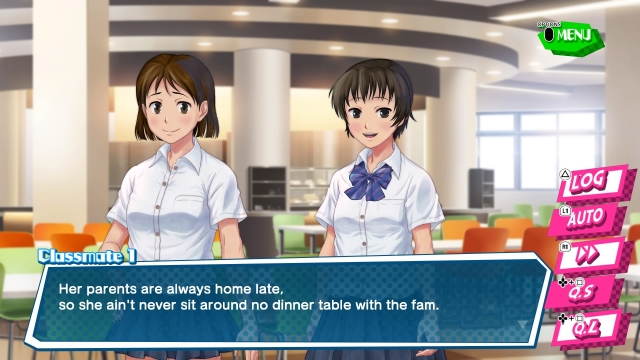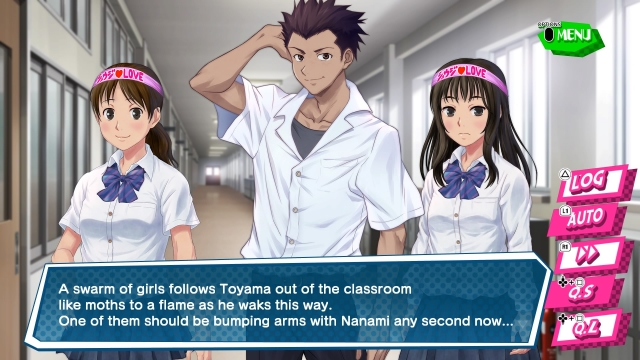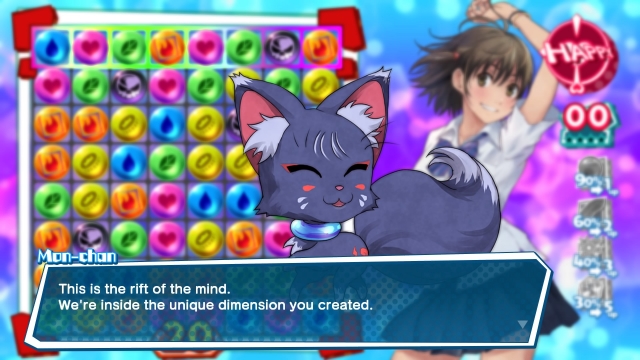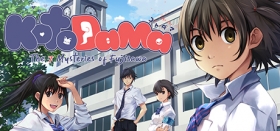
Kotodama: The 7 Mysteries of Fujisawa Review
Despite the fact there are dozens of games like it, if you were to hear the words ‘visual novel with match-three elements’, you’d be forgiven for thinking of just one title. While Kotodama: The 7 Mysteries of Fujisawa bears more than a passing resemblance to the infamous dating sim HuniePop, fortunately its similarities are only skin deep. Sure, in both games you’ll be stripping characters down to their underwear, but that’s as far as Kotodama goes. It’s not a dating sim, there’s no love interest, it’s a mystery novel with some fanservice thrown in.
Set in a prestigious Japanese Academy, Kotodama follows a new transfer student as they set about unravelling myths surrounding the school. Having been roped into joining the Occult Research Club, it’s the players job to investigate and solve seven urban legends. Having made a deal with a demon fox, you have the ability to strip away the lies and find the truth in whatever people say. Though the demon, Mon-Chan, insists you can do this by, say, visualising an onion being peeled, the characters chosen method of finding the truth is to imagine the person in question being completely undressed, one layer of clothing at a time.

In order to disrobe your classmates in your head, you’ll be playing a match-three game. Unlike other matching-tile games like Bejeweled or Candy Crush Saga you won’t be swapping two icons to make connections. In Kotodama selecting a tile sends it to the top of its current column, dropping the rest down to fill the gap that it made. Lines of three or more matching coloured orbs can be made vertically or horizontally, with each character you’ll be stripping having a certain colour preference.
Taking off the potential liars’ clothing is tied to something called the happiness gauge. If you manage to line up at least three matching symbols you’ll fill the target’s happiness meter, depending on how many were lined up and if that triggered a combo. Moving one of the tiles costs a turn, and every quarter of the happiness gauge you fill grants you a few extra turns; it’s all pretty standard fare. Find yourself lacking in moves and you can try out ‘challenges’ to give you a few more. These are simply items you can take to poke the targets body with. Each item has a percentage chance to fail and upset the person instead, with the items that reward more turns having a lower success rate. Fail and you’ll be slapped with a penalty, different ones depending on who you’re stripping, and a minor decrease in the happiness meter.

The different icons on the board have different attributes, all based on their colour, and it’s possible to level up these attributes so they fill more of the gauge when you connect them. To do this you’ll need to find keywords, phrases spoken by people during your investigations if you manage to steer the conversation the right way. Once spoken, these words get stored in a magic book, where you can look to see what you have and how many you are missing in each chapter. Every investigation has a secret special phrase with no attribute associated with it. These words are particularly hard to find, and can only be gotten through playing the chapter to get its ‘true’ end, which takes a bit more effort than just talking to everyone and hoping.
As each chapter starts you’ll be given the option to investigate around the school, selecting different areas to visit while hunting for any clues about a particular myth. Some people will only show up if you visit the areas in a particular order, and some won’t show up until your second or third playthrough, meaning it’s impossible to get the full story, and all associated keywords, on your first try.

Storywise Kotodama is constantly evolving. Given the nature of how the chapters change with each subsequent playthrough, what you assumed was the end of an investigation can turn out to be only the beginning of something far deeper and darker than first assumed. Indeed the more you play the more twisted the story surrounding Fujisawa Academy becomes. The main issue is getting that far. Early level repetition due to the nature of the story can become boring very quickly, as changes in the story are dependant on if the player makes the correct choices, fail and you’ll be stuck watching the very same conversations unfold every time. It’s a shame that a fun game, and genuinely interesting plot, is hidden behind a three-hour mire that can only be described as an introduction, as you’ll be forced to play the first chapter a few times just to make sure you understood the repeating nature.

To start off each investigation will have one match-three game in them; a straightforward inquiry doesn't require you to quiz many people after all. The mystery of the broken vase, for example, needs you to simply ask if someone did the deed, and detect if they are telling the truth. As you progress these matches increase in number, and difficulty, until having three or four per chapter isn’t uncommon. If you were not too diligent collecting keywords you may struggle to satisfy people's happiness later on, thanks to the difficulty spike. That said, if you didn’t collect keywords then that means you didn’t fully investigate, and you will likely end up stuck in a story loop until you find the right order of exploration that gives you the phrases you were missing.
That is the game’s major flaw. Once you have successfully completed a chapters ‘true’ end, it’s not over. Should you fail to maneuver a later investigation correctly you’ll be back at the very start once more. You can abuse the games quick save feature to ensure you make the right choices in your conversations, sure, but while it seems you may have picked the right order at the time, there is a chance you missed something pertinent to a later case. The word book in the menu is a great way to track how you are doing in a chapter, with keywords you are missing showing up as question marks in the book, but it doesn’t let you know if you got events in the right order. After all, it’s possible to get certain words in one playthrough, but miss them in the subsequent ones, as they stay in the book once obtained. It’s incredibly frustrating, being doomed to play the same chapter over and over, without knowing if the fact you’re stuck is because you missed something in a seemingly unrelated case.

Kotodama: The 7 Mysteries of Fujisawa feels like a short mobile game in a bigger game’s clothing. It looks and plays like it was designed around a phone’s touchscreen in mind. Reminders of menu shortcuts remain stuck to the screen at all times in such a way that they resemble onscreen buttons. The one-click nature of the match three feels incredibly dull, and controlling with an analogue stick feels sluggish and clunky, though it’s very possible the game was made for use with a mouse. The overly-simplistic design of the menus and general style of the art direction leave the whole game a slight amateur air.
The last point of frustration is the localization. While the story is enjoyable and the translation perfectly decent, spelling errors litter the game. Not only that, some speech in the Japanese version of the game is left in, despite the translation not being included. This leaves several blank text boxes popping up while characters talk. Inconsistent writing styles have some of the high schoolers talking in terrible slang, that feels forced, for parts of conversations yet talking normally in others. These overlooked errors have the whole experience feeling rushed.
It’s a shame that several small mistakes and minor quality of life changes are what stand in the way of Kotodama: The 7 Mysteries of Fujisawa being an excellent little game. Unfortunately the story bloating through repetition and lack of polish are enough to harm the overall experience. The whole system of stripping people into their underwear is horse-shoed in, having no bearing on the story and clashing with the game’s themes, it’s like it was put there simply because it was expected. All this said, it’s still a fun game, and worth looking into if you are a fan of games in this vein. Just don’t expect it to be anything groundbreaking or unique.
Kotodama: The 7 Mysteries of Fujisawa (Reviewed on PlayStation 4)
Game is enjoyable, outweighing the issues there may be.
A fun game, and worth looking into if you are a fan of games in this vein. Just don’t expect it to be anything groundbreaking or unique.










COMMENTS